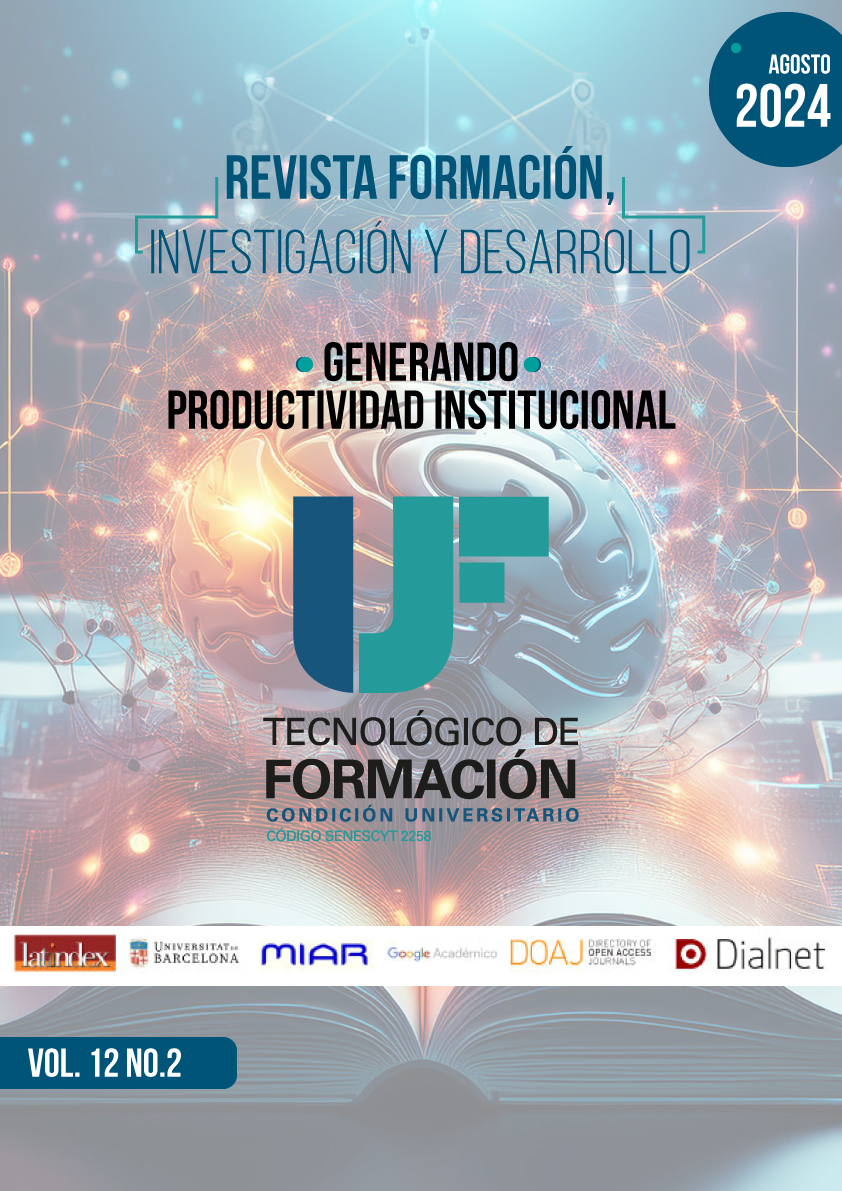Innovations in Physical Activity Through Artificial Intelligence.
Main Article Content
Abstract
This is a theoretical review article that explores the impact of new technologies that are transforming teaching methods in education, with a special emphasis on artificial intelligence and its application in physical activity. The objective is to investigate, analyze and understand the effects of how artificial intelligence can be personalized and adapted to exercise programs in an individualized way, thus improving physical fitness in the long term. The methodology used has been thoroughly verified in the existing literature, which focused on empirical and theoretical research aimed at reviewing the impact of physical activity through artificial intelligence. The results indicated that this technology is improving the participation and motivation of students and the general public, thus allowing individualized learning, or rather facilitating access to the information collected. To conclude, the article highlights the importance of addressing the challenges of an effective implementation of technology with sports and all types of teaching in physical activity.
Article Details

This work is licensed under a Creative Commons Attribution-NonCommercial-ShareAlike 4.0 International License.
Este trabajo tiene licencia DE Atribución/Reconocimiento-NoComercial-CompartirIgual 4.0 Internacional. CC BY-NC-SA 4.0.
How to Cite
References
An R, Shen J, Xiao Y (2022) Applications of Artificial Intelligence to Obesity Research: Scoping Review of Methodologies J Med Internet Res 2022;24(12): e40589 DOI: 10.2196/40589. https://www.jmir.org/2022/12/e40589
Araújo, D., Couceiro, M., Seifert, L., Sarmento, H., & Davids, K. (2021). Artificial Intelligence in Sport Performance Analysis (1st ed.). Routledge. https://doi.org/10.4324/9781003163589
Bentley, D. J. (20 de noviembre de 2022). Special Issue "Artificial Intelligence in Sports Injury and Injury Prevention". MDPI. Obtenido de https://www.mdpi.com/journal/sports/special_issues/Artificial_Prevention
Eetvelde, Hans & De Michelis Mendonça, Luciana & Ley, Christophe & Seil, Romain & Tischer, Thomas. (2021). Machine learning methods in sport injury prediction and prevention: a systematic review. Journal of Experimental Orthopaedics. 8. 27. https://www.researchgate.net/publication/350883426_Machine_learning_methods_in_sport_injury_prediction_and_prevention_a_systematic_review
Echeverría, J. (2020). Filosofía de la innovación y valores sociales en las empresas. Filosofía de la innovación y valores sociales en las empresas, 77-99. https://www.torrossa.com/en/resources/an/4647952#
Fondo de las Naciones Unidad para la Infancia (2019). La actividad física en niños, niñas y adolescentes. Prácticas necesarias para la vida. www.unicef.org/lac
Goh Y, Ow Yong J, Chee B, Kuek J, Ho CMachine Learning in Health Promotion and Behavioral Change: Scoping ReviewJ Med Internet Res 2022;24(6): e35831 https://www.jmir.org/2022/6/e35831 DOI: 10.2196/35831
Gómez, C., Del Pozo, C., Martínez, C., y Martín, A. (2020). La inteligencia artificial al servicio del bien social en América Latina y el Caribe. Panorámica regional e instantáneas de doce países. fAIr LAC. http://dx.doi.org/10.18235/0002393
Harrison, TM y Luna-Reyes, LF (2022). Cultivando inteligencia artificial confiable en el gobierno digital. Revisión de informática de ciencias sociales, 40 (2), 494-511. https://doi.org/10.1177/0894439320980122
Kakavas G, Malliaropoulos N, Pruna R, Maffulli N. Inteligencia artificial: una herramienta para la predicción de traumas deportivos. Herida. Agosto de 2020; 51 Supl. 3: S63-S65. doi: 10.1016/j.injury.2019.08.033. Epub 2019 de agosto de 19. PMID: 31472985. https://pubmed.ncbi.nlm.nih.gov/31472985/
Kumar, G., Kumar, M., Reddy, S., Kumari, B., & Reddy, C. (2023). Injury Prediction in Sports using Artificial Intelligence Applications: A Brief Review. Journal of Robotics and Control (JRC), 5(1), 16-26. https://doi.org/10.18196/jrc.v5i1.20814
Le Noury, P., Polman, R., Maloney, M. et al. Una revisión narrativa del estado actual de la tecnología de realidad extendida y cómo se puede utilizar en el deporte. Deportes Med 52 ,1473–1489 (2022). https://doi.org/10.1007/s40279-022-01669-0
Lim, J. (2023). Inteligencia artificial generativa: qué es, qué no es y qué puede significar para Naciones Unidas. https://www.un.org/es/crónica-onu/inteligencia-artificial-generativa-qué-es-qué-no-es-y-qué-puede-significar-para-naciones
Materne O, Chamari K, Farooq A, et al. Association of Skeletal Maturity and Injury Risk in Elite Youth Soccer Players: A 4-Season Prospective Study With Survival Analysis. Orthopaedic Journal of Sports Medicine. 2021;9(3). https://doi:10.1177/2325967121999113
Miller, W., & Morris, L. (1999). Managing Knowledge, Technology, and Innovation. Ogden: Wiley.
Naranjo, J., Sanz, R., y Jiménez, D. (2008). Cultura organizacional e innovación. Un estudio empírico. Dialnet, 1-18. Obtenido de https://dialnet.unirioja.es/descarga/articulo/2710833.pdf
Organización Mundial de la Salud. (2020). Directrices de la OMS sobre actividad física y hábitos sedentarios: de un vistazo https://www.who.int/es/publications/i/item/9789240014886
Perea, C. A., López N. G., Perea M. A., Reyes G. U., Lagunes, S., Ríos G. P., De La Paz Morales, C. (2019). Importancia de la Actividad Física. Médico-Científica de la Secretaría de Salud Jalisco, 121-125. https://www.medigraphic.com/pdfs/saljalisco/sj-2019/sj192h.pdf
Physical Activity and a Healthy Diet: Viewpoint J Med Internet Res 2020;22(9):e22845 DOI: 10.2196/22845 https://www.jmir.org/2020/9/e22845
Ríos-Campos, C., Tejada-Castro, MI, Del Viteri, JCL, Zambrano, EOG, Núñez, JB, & Vara, FEO (2023). Ética de la inteligencia artificial. Revista de Desarrollo del Sur de Florida, 4 (4), 1715–1729. https://doi.org/10.46932/sfjdv4n4-022
Scott-Briggs, A. (2021). Top Useful Technologies In Smartwatches That Are Handy For Your Everyday Life. https://techbullion.com/top-useful-technologies-in-smartwatches-that-are-handy-for-your-everyday-life/
Schumpeter, J. (1978). Teoría del desenvolvimiento económico. México: Fondo de Cultura Económica.
Solas-Martínez, J.L., Suárez-Manzano, S., De la Torre-Cruz, M.J., Ruiz-Ariza, A. (2023). Artificial Intelligence and Augmented Reality in Physical Activity: A Review of Systems and Devices. In: Geroimenko, V. (eds) Augmented Reality and Artificial Intelligence. Springer Series on Cultural Computing. Springer, Cham. https://doi.org/10.1007/978-3-031-27166-3_14
UNESCO Carta Internacional de la Educación física, la actividad física y el deporte https://unesdoc.unesco.org/ark:/48223/pf0000235409_spa
Wang, Z., Meng, D., He, S., Guo, H., Tian, Z., Wei, M., Yang, G., & Wang, Z. (2022). The Effectiveness of a Hybrid Exercise Program on the Physical Fitness of Frail Elderly. International journal of environmental research and public health, 19(17), 11063. https://doi.org/10.3390/ijerph191711063
Wong DC, O'Connor S, Stanmore E. The Application of Artificial Intelligence in Digital Physical Activity and Falls Prevention Interventions for Older Adults. J Aging Phys Act. 2023 https://doi.org/10.1123/japa.2022-0376.
Yang Y, Boulton E, Todd CMeasurement of Adherence to mHealth Physical Activity Interventions and Exploration of the Factors That Affect the Adherence: Scoping Review and Proposed FrameworkJ Med Internet Res 2022;24(6):e30817 https://www.jmir.org/2022/6/e30817 DOI: 10.2196/30817
Zhang J, Oh YJ, Lange P, Yu Z, Fukuoka Y. Artificial Intelligence Chatbot Behavior Change Model for Designing Artificial Intelligence Chatbots to Promote Physical Activity and a Healthy 2020https://www.researchgate.net/publication/346532020_Artificial_Intelligence_Chatbot_Behavior_Change_Model_for_Designing_Artificial_Intelligence_Chatbots_to_Promote_Physical_Activity_and_a_Healthy_Diet_Viewpoint

